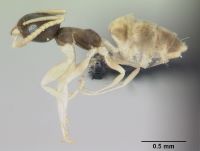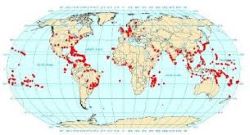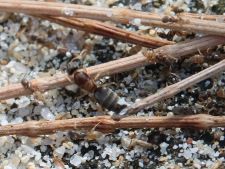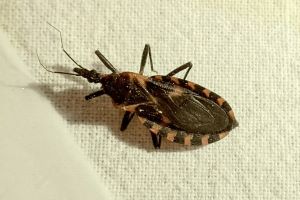Ghost Ant
Taxonomy
| Kingdom | Phylum | Class | Order | Family | Genus | Species | |
|---|---|---|---|---|---|---|---|
| Classification | Animalia | Arthropoda | Insecta | Hymenoptera | Formicidae | Tapinoma | Melanocephalum |
Species Description

The ghost ant (Tapinoma melanocephalum) is a small species of ant belonging to the phylum "Arthropoda" that is found in tropical regions throughout the world. Much like other members of the family "Formicidae", Tapinoma melanocephalum are eusocial and have a caste system within their colonies. The workers of ghost ant colonies are small, typically growing to roughly 1.5 mm (1/16 in.) in length. The ants are bicolored, with their head and thorax being black in color, while the abdomen and legs of the worker appear to be a pale color that looks almost translucent.[2] The species also gets their name from their unique color pattern. Due to their small size and almost transparent body they can be difficult to see, and can be described as "fading" or even "ghostly" when they are being observed. The fading affect is enhanced when the ants are seen on lighter colored surfaces, which makes them more difficult to see.[3]
Distribution

The ghost ant is an invasive species in many parts of the world. The origin of the ants was thought to be in the tropics of Africa or Asia.[4] Due to the rapid spread of the insects, the exact location for their origin is unknown. They are found commonly in the Southern United States, in tropical environments like Florida, but have been seen in temperate climates, and have been identified as far north as Winnipeg, Canada.[2] They are more common in tropical habitats, but due to the species being highly invasive and having a high survivability, they are able to inhabit temperate areas by nesting indoors. They are more likely to do this while they are in search of food, seeking protection from the harsh weather, or evading predators. Regardless, this behavior results in the species being labeled as a pest in residential areas. Typically though, they will nest in soil under places like rock, logs, or in leaf litter and rotting wood.[3] Their incredible survivability is, largely due to their means of communication with other worker ants within the colony. By using pheromones to signal to other workers within their colony of 6-Methyl-5-hepten-2-one and actinidine, the ants can send out alarm signals to warn them of any violent encounters. Other pheromones are equally important, including signals sent to notify the colony of food sources.[4]
Diet
Ghost ants are generalists and omnivores. In an outdoor setting, the worker ants of the colonies will go out and forage for food such as small insect larvae, living and dead insects, as well as food that is higher in carbohydrate concentrations such as honeydew. The honeydew that is harvested is secreted by aphids or other insects that primarily feed on plant material. The worker ants will bring these foods back to their colonies to share with the other workers and the queens.[4][5] Because the species is a common pest species that tends to nest indoors in search of food, they will typically change their diet in an indoor setting. While they are indoors, they will forage for sweeter food sources and also gather near areas with greasy food residues, such as stovetops or trash cans.[3]
Life Cycle

Tapinoma melanocephalum form colonies that have multiple queens, meaning they are polygynous. This is a standout feature for ghost ants, but the behavior is also seen in other ant species such as the acorn ant (Temnothorax curvispinosus). The colony is unicolonial, which means that the ants live in separate nests with different queens, but they all work together and take care of each other. Each colony can consist of anywhere from 100 workers up to 1000 workers within the larger nests. Although ghost ant queens only survive for a few weeks, they are able mate and reproduce with fertile males within the colony and produce up to 5 eggs per day. Five eggs per day may seem miniscule in comparison to the large colony size, however due to the colonies having multiple fertile queens, their numbers are able to grow rapidly. Development of the new larvae takes anywhere between 16-52 days, and they go through 4 instars between the time they hatch until they reach adulthood.[4] Ghost ant colonies also reproduce via budding. The colonies will carry out this behavior if they either need to expand their territory, or if there is a disturbance that threatens the survival of the colony. When this happens, the ants from the nest will relocate, and bring a queen, several workers, as well as eggs, larvae, and pupae. This behavior increases their survivability, and helps ghost ants expand to new territory, which is part of the reason why they are a highly adaptive and resistant invasive species.[3]
Ecological Significance

As previously mentioned, T. melanocephalum is a widespread invasive species, and due to its survivability is commonly seen as a pest among households. Because they consume honeydew as a food source, they have been observed protecting honeydew producing insects like aphids, which are another pest insect that can pose a threat in places like greenhouses. However, the ants also prey on the two-spotted spider mite (Tetranychus urticae), which is another harmful plant pest. Because of their acts predation and aggression towards the mites, there is a slight benefit of having the ants around these areas.[8] T. melanocephalum has been observed making their nests near jumping spiders, and appear to have a symbiotic relationship with them. The spiders will protect the ants from predation and parasitism, while the ant nests provide a solid structure to form the basis of the jumping spider's webs. Even though the ants are not directly dangerous if contact with them is made, ghost ants have been noted to be carriers of pathogens such as Staphylococcus, making the ants more dangerous if they are in buildings such as hospitals.[4] Although the ants have the likelihood to spread diseases to humans, they have also been known to prevent them. The ants have been seen feeding on the eggs of Rhodnius prolixus, otherwise known as the kissing bug. The insect is one of the known vectors of Chagas' disease, which is known to cause afflicted people cardiac or neurological disorders if left untreated. In these areas, the rates of the disease appear to be lower.[9][10]
References
- ↑ “Specimen: CASENT0008659 Tapinoma melanocephalum.” AntWeb, https://www.antweb.org/bigPicture.do?name=casent0008659&shot=p&number=1
- ↑ 2.0 2.1 “Ghost Ant, Tapinoma melanocephalum.” Urban and Structural Entomology Program at Texas A&M University, https://urbanentomology.tamu.edu/urban-pests/ants/ghost/
- ↑ 3.0 3.1 3.2 3.3 “What Are Ghost Ants and How Do I Kill Them.” Imperial Pest Prevention, https://www.imperialpestprevent.com/post/ghost-ants-and-how-to-kill-them#:~:text=What%20Do%20Ghost%20Ants%20Look,abdomen%20and%20legs%20is%20key.
- ↑ 4.0 4.1 4.2 4.3 4.4 4.5 “Tapinoma melanocephalum (Ghost Ant).”UWI-The Online Guide to the Animals of Trinidad and Tobago, https://sta.uwi.edu/fst/lifesciences/sites/default/files/lifesciences/documents/ogatt/Tapinoma_melanocephalum%20-%20Ghost%20Ant.pdf
- ↑ “Common Ant Species: Ghost Ants” Terro, https://www.terro.com/ghost-ants#:~:text=Diet,ghost%20ants%20usually%20prefer%20sweets.
- ↑ “Ghost ant queens in Phuket, Thailand.” Ants New Jersey, https://antsnj.com/ghost-ant-queens-in-phuket-thailand
- ↑ “This deadly 'kissing bug' has been mostly ignored. It shouldn't be, this author says.” NBC News, https://www.nbcnews.com/news/latino/deadly-kissing-bug-mostly-ignored-shouldnt-author-says-rcna1678
- ↑ “Ant Spotlight: Ghost Ants” Hulett Environmental Services, https://www.bugs.com/blog/ant-spotlight-ghost-ants/
- ↑ “Ghost Ant, Tapinoma melanocephalum (Fabricius) (Insecta: Hymenoptera: Formicidae)” ResearchGate, https://www.researchgate.net/publication/224497252_Ghost_Ant_Tapinoma_melanocephalum_Fabricius_Insecta_Hymenoptera_Formicidae
- ↑ “Chagas disease (also known as American trypanosomiasis)” World Health Organization, https://www.who.int/news-room/fact-sheets/detail/chagas-disease-(american-trypanosomiasis)